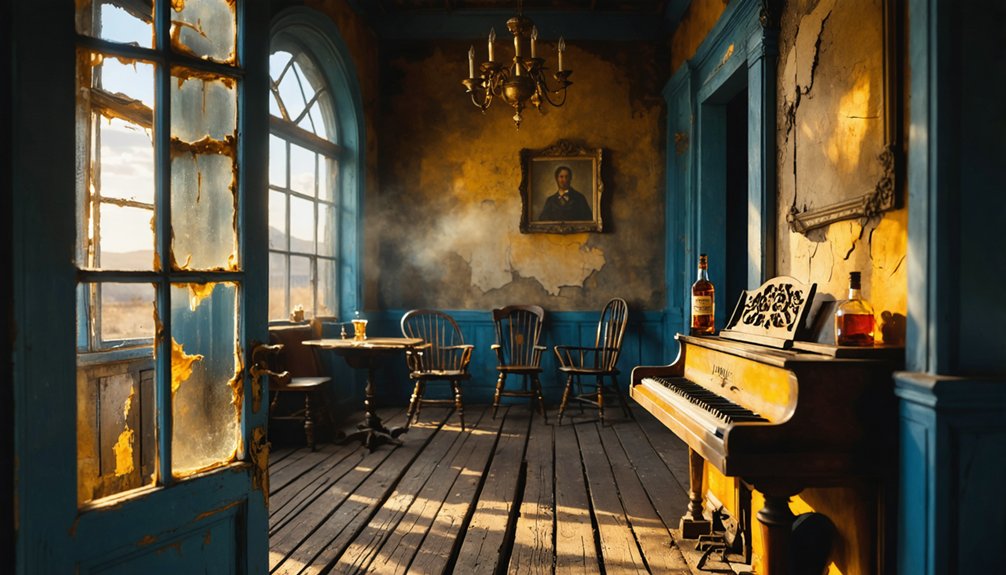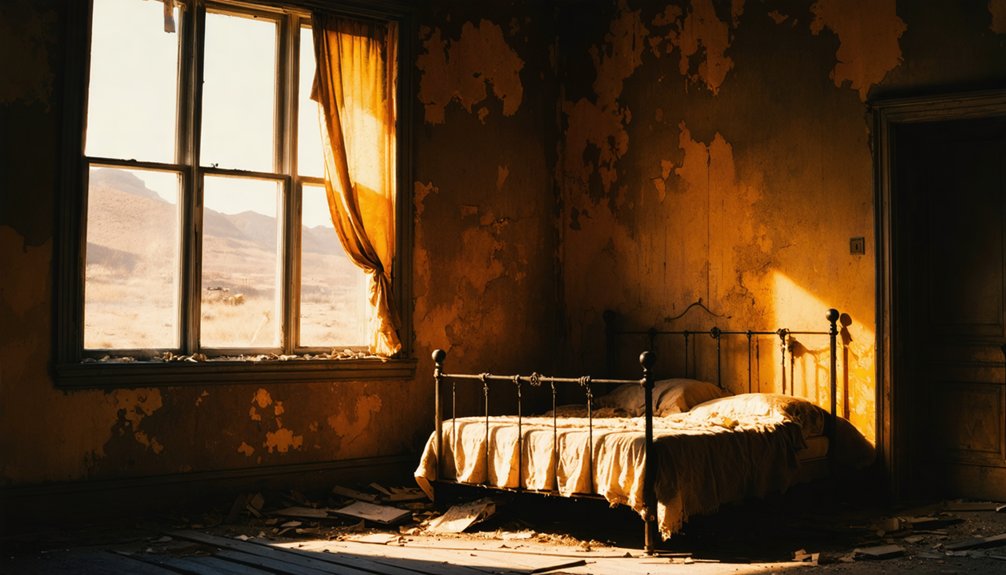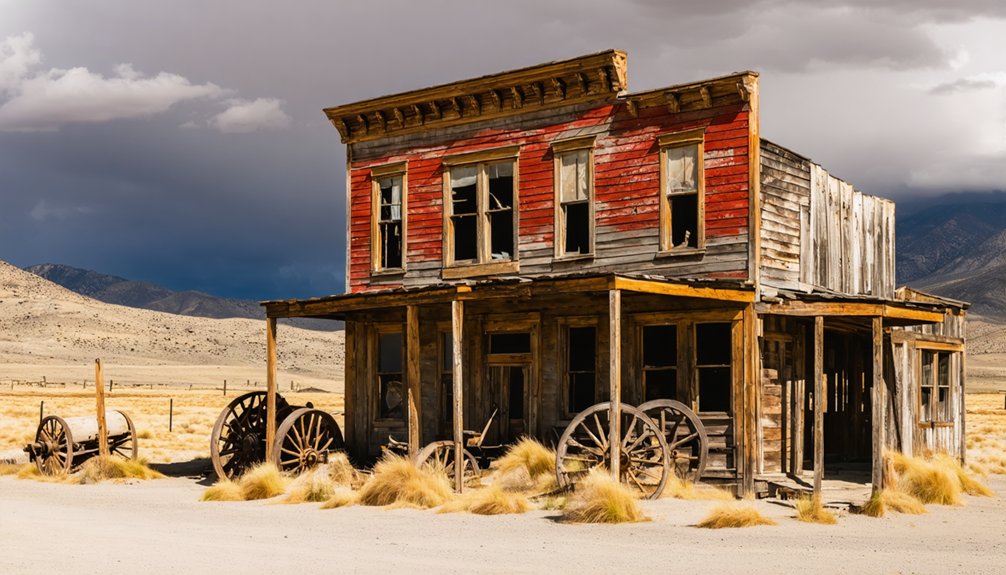America’s ghost towns offer chilling glimpses into abandoned pasts where time stands still. You’ll encounter mining settlements like Bodie, California with reported paranormal activity, and disaster-struck communities like Centralia, Pennsylvania, where underground fires still burn. These haunting remnants feature decaying structures, eerie silence, and tales of spectral residents tied to violent histories. From toxic environmental catastrophes to towns with unexpected origins, these forgotten places reveal humanity’s most unsettling abandoned chapters.
Key Takeaways
- Bodie, California and Bannack, Montana are infamous for numerous documented ghostly encounters and paranormal activity.
- Pripyat, Ukraine remains a frozen-in-time testament to the 1986 Chernobyl disaster with abandoned possessions creating an eerie atmosphere.
- Centralia, Pennsylvania’s underground coal fire has burned since 1962, creating sinister steam vents and collapsed roadways.
- Kennecott, Alaska reportedly experiences unexplained phenomena including eerie voices and flying tools during restoration work.
- St. Elmo, Colorado features the ghost of former resident Annie Stark appearing in hotel windows after dying during a devastating epidemic.
Abandoned Mining Towns Frozen in Time
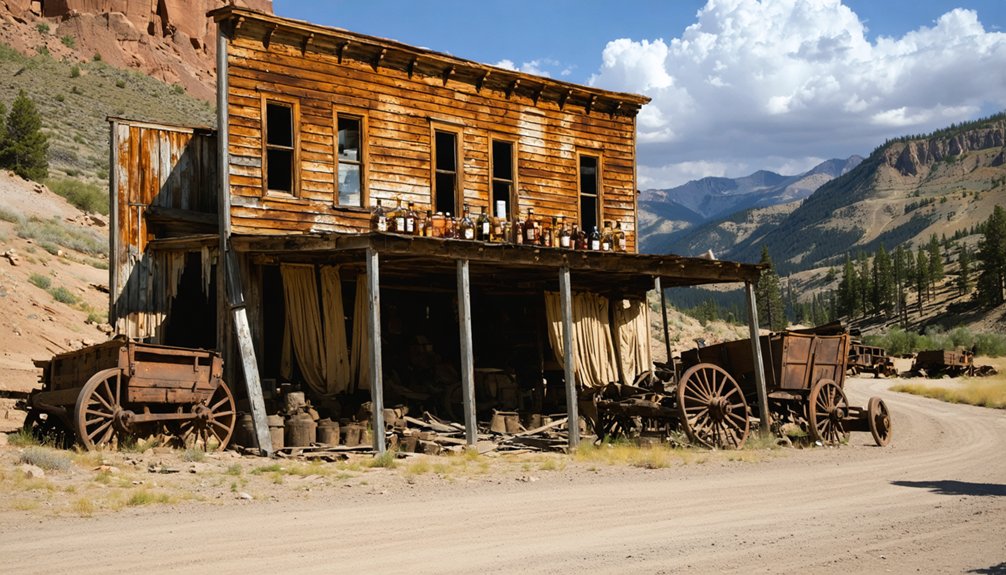
When prospectors uncovered precious metal deposits in remote landscapes across the American West, these sites rapidly transformed from uninhabited wilderness into bustling economic centers.
You’ll find the most dramatic examples in towns like Bodie, California, where gold discoveries in the 1870s attracted 10,000 residents, and Rhyolite, Nevada, which quickly developed stock exchanges, schools, and electric plants following nearby strikes.
These mining legacies reveal a pattern: settlements that became ghost towns were typically smaller, isolated from markets, and overly dependent on single industries.
The rise and fall of Western mining towns offers a cautionary tale in economic diversification and geographic isolation.
When ore quality diminished or national economic shifts occurred between 1910-1940, mass exoduses followed. In towns like Castle Dome, the transition from silver to lead deposits significantly impacted their economic viability.
The frontier mining boom that began with the California gold discovery in 1848 sparked a massive pursuit of mineral wealth across the western territories.
Today, ghostly remnants like Bodie’s 110 preserved structures and St. Elmo’s well-maintained buildings offer glimpses into boom-and-bust cycles that defined America’s resource-driven expansion.
Towns Swallowed by Environmental Catastrophes
Unlike the mining towns that gradually faded as economic opportunities dwindled, some communities met more sudden and devastating ends.
Environmental catastrophes have permanently erased entire towns from habitation, leaving behind chilling reminders of humanity’s vulnerability to both natural and man-made disasters.
- Times Beach, Missouri became uninhabitable after toxic contamination from dioxin levels 300 times above safety standards.
- Centralia, Pennsylvania’s underground coal fire continues burning since 1962, forcing evacuation as sinkholes and toxic gases made life impossible.
- Plymouth, Montserrat vanished under pyroclastic flows from volcanic destruction in 1997, killing 19 and prohibiting redevelopment.
- Pripyat, Ukraine stands frozen in time following the 1986 Chernobyl disaster, with radiation levels making it unsafe for human return.
Love Canal in Niagara Falls forced the evacuation of over 800 families when toxic chemical waste began leaching into homes after containment barriers failed.
Visitors to Pripyat today can see schools with books and chalkboards left in place, creating an eerie time capsule effect of Soviet life suddenly interrupted.
America’s Most Haunted Ghost Towns and Their Spectral Residents
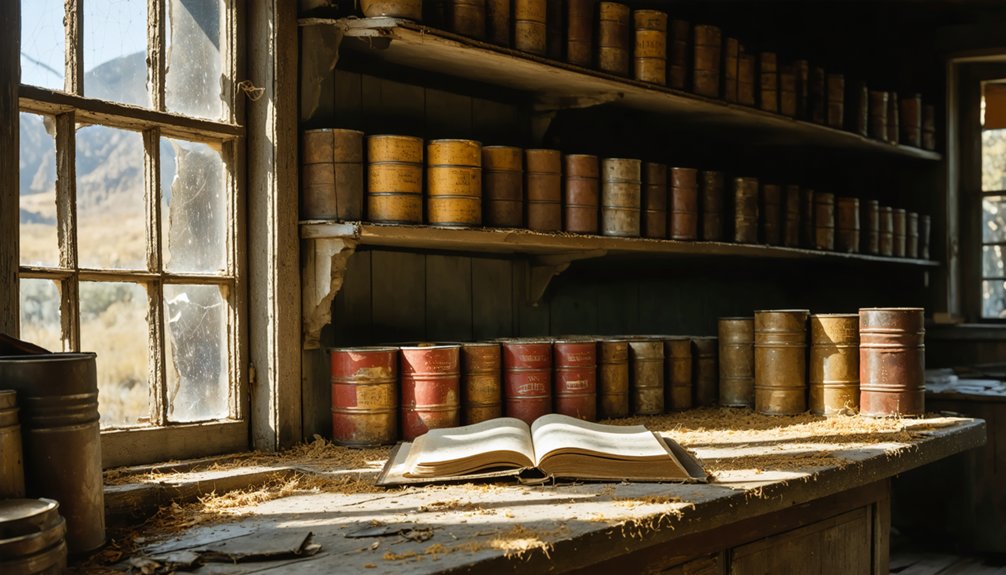
Beyond the ruins of once-thriving communities lies a more unsettling dimension of America’s ghost towns: their spectral inhabitants who seemingly refuse to depart.
Forgotten places where history lingers and spirits stay—America’s ghost towns harbor both memories and restless souls.
You’ll find these persistent spirits particularly concentrated in former mining settlements like Bodie, California and Bannack, Montana, where violent histories have spawned numerous ghostly encounters. In Bodie, over 200 preserved frontier buildings serve as backdrop for spectral stories linked to 1880s lawlessness.
The geographical distribution of hauntings often reflects historical trauma—Civil War prisoners manifest in Cahaba, Alabama’s ruins, while mining-related deaths fuel paranormal accounts in places like Ruby, Arizona and Garnet, Montana. In Kennecott, Alaska, preservation workers have reported eerie voices and flying tools while restoring the abandoned copper mining facilities. St. Elmo, Colorado adds to this pattern with Annie Stark’s ghost reportedly appearing in hotel windows after she remained in the town long after others departed.
Specific structures, such as Bannack’s Hotel Meade and the Winchester Mystery House, have become epicenters of paranormal activity, their architectural features seemingly designed to accommodate both living visitors and permanent ethereal residents.
Preserved Ruins: Walking Through History’s Forgotten Places
Throughout the silent corridors of time, preserved ghost town ruins stand as tangible portals into humanity’s forgotten chapters. When you walk through Pompeii’s ash-preserved streets or witness Kolmanskop’s sand-swallowed buildings, you’re experiencing direct communion with historical artifacts that survived civilization’s ebb and flow.
- Hashima Island’s densely packed industrial structures reveal Japan’s dramatic economic shifts.
- Medieval Craco’s 13th-century castle stands defiant against time’s erosion.
- Architectural preservation at Ostia Antica showcases Rome’s sophisticated seaport engineering.
- Kolmanskop’s colonial buildings emerge partially from desert sands, displaying natural reclamation.
In Italy, Pompeii offers extraordinary insights into Roman daily life after being naturally preserved by volcanic ash from Mount Vesuvius in 79 AD.
Nevada’s landscape offers over three hundred ghost towns that silently chronicle the boom-and-bust cycle of American mining ventures. These sites balance delicate preservation challenges with educational access, offering you glimpses of collapsed economies, natural disasters, and abandoned dreams—physical evidence of humanity’s resilience and impermanence preserved in stone, brick, and memory.
Beyond Gold Rush: Unexpected Origins of America’s Eeriest Ghost Towns
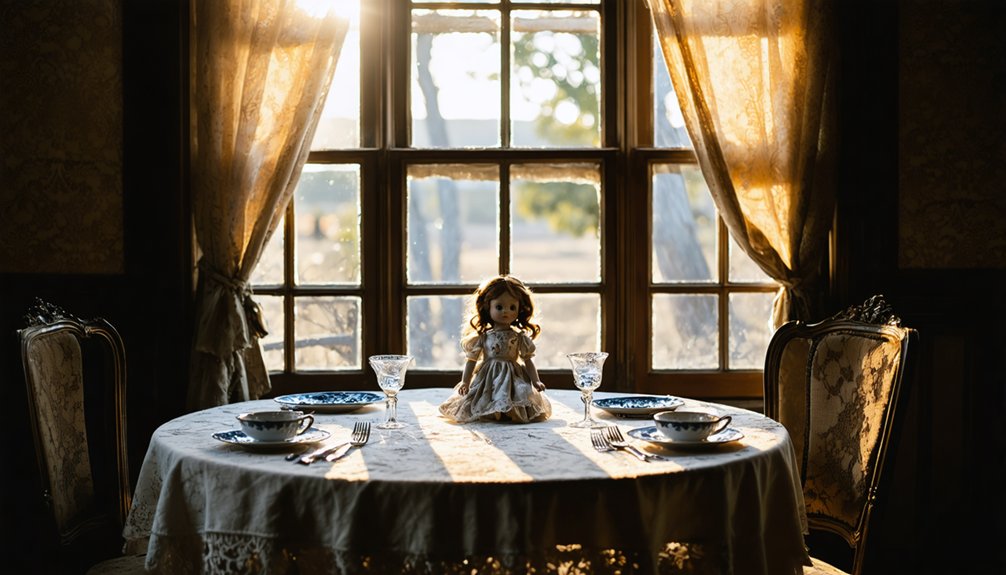
When most people envision America’s ghost towns, gold rush settlements often dominate the collective imagination, yet a rich tapestry of abandoned communities emerged from surprisingly diverse origins across the nation’s landscape.
America’s forgotten places tell stories far beyond gold fever—each abandoned town preserves a unique chapter in our national narrative.
You’ll find places like Centralia, Pennsylvania, where an underground coal fire has burned since 1962, rendering the town uninhabitable due to toxic gases and ground instability.
Non-mining origins characterize towns like Cahawba, Alabama—once a thriving state capital abandoned after persistent flooding—and Batsto Village, New Jersey, which emerged from iron and glass production rather than precious metals.
Some communities boast unusual founding stories, such as Panamint City, California, established by outlaws following a silver theft.
Transportation changes sealed the fate of numerous settlements when railroad closures isolated once-prosperous communities from crucial economic lifelines. St. Elmo, Colorado exemplifies this pattern as the town began its decline when the Alpine Tunnel closed in 1910, cutting off vital railway connections.
Flagstaff, Maine offers a unique underwater ghost town experience, as the entire community was intentionally flooded in the 1950s to create a hydroelectric project, leaving the town’s remains submerged beneath Flagstaff Lake.
Frequently Asked Questions
Can You Legally Remove Artifacts From Ghost Towns?
No, you can’t legally remove artifacts from ghost towns. Artifact preservation laws protect these sites on public lands, and you’ll face serious legal consequences including fines and imprisonment for violations.
Are There Still-Inhabited Ghost Towns With Functioning Services?
You’ll discover paradoxical inhabited “ghost towns” where remaining locals maintain limited services while capitalizing on ghost town tourism. These communities preserve infrastructure and local ghost stories despite significant population decline and service reduction.
What Safety Precautions Should Visitors Take When Exploring Ghost Towns?
You’ll need proper safety gear including sturdy boots, respirators, and first-aid kits when exploring abandoned structures. Maintain wildlife awareness by making noise and carrying deterrents to avoid surprising potentially dangerous animals.
How Do Ghost Towns Differ Internationally From American Examples?
Walking through crumbling Soviet housing blocks reveals how international ghost towns differ from America’s mining remnants. You’ll notice varied cultural significance, architectural styles, abandonment causes, and approaches to historical preservation internationally.
Which Ghost Towns Are Most Accessible for Mobility-Impaired Visitors?
You’ll find Ghost Town Museum in Colorado Springs and Goldfield Ghost Town in Arizona offer the most accessible routes with wheelchair friendly sites, featuring ramped paths and RFID customization for various mobility needs.
References
- https://nightofthejack.com/2025/01/23/top-creepy-ghost-towns-in-america/
- https://www.christywanders.com/2024/08/top-ghost-towns-for-history-buffs.html
- https://www.visittheusa.com/experience/5-us-ghost-towns-you-must-see
- https://www.geotab.com/ghost-towns/
- https://www.youtube.com/watch?v=yeTVfoQxqJc
- https://www.atlasobscura.com/lists/americas-best-preserved-ghost-towns
- https://en.wikipedia.org/wiki/Lists_of_ghost_towns_in_the_United_States
- https://jasontdunn.com/files/ghost_towns_big_cities.pdf
- https://westernmininghistory.com/map/
- https://en.wikipedia.org/wiki/Ghost_town
